
|
Hello, Friend! “Bless Their Hearts” was a phrase I often heard from my elders as I was growing up in the Bible Belt. The expression was often employed to describe benighted folks like the heathens who we sent missionaries to convert. Or perhaps Catholics, who simply didn’t know better. I moved far away, but the phrase migrated with me. As a know-it-all twenty something I peppered it into my conversations, usually in a slightly superior tone. This made it easier to offer my scathing judgements and still appear to be a nice person. For a while this meant anyone who was not in the hip counter-culture created and populated by my generation got their hearts blessed. Gradually humbled by life and my own imperfections, I stopped blessing their hearts too. Sometime during the last three election cycles I’ve noticed my old sarcasm coming to the rescue. A sense of superiority can easily be camouflaged itself as humor, I learned. I’ve blessed the hearts of great swaths of politicians who seem clueless. I called it a coping strategy. Today I’m a bit embarrassed to admit to any of it. Let’s just say it didn’t reflect my higher self. It also doesn’t serve the world when I stay for long in a shell of self-protection and sarcasm. There’s something to be said for that in normal times. Which these are not. What most of my friends and clients most need now is a way to soothe their own nervous systems. This is something I frequently forget to do for myself, despite my best intentions. Over the decades (with the help of therapy) I’ve come to realize how little self-soothing was on the agenda for me when I was a baby. No blankie. No thumb-sucking. No favorite binkie or plush toy for me. This was a point of pride for my parents. Then, last summer, along came grandbaby Juniper, the little spirit who captured my heart. Almost since birth Juniper has been a prize-winning self-soother. When things have been too stimulating or she’s tired, she naturally pats herself softly on her cheek or chest. She often dozes off immediately. As she has grown into herself during her first year, her love pats have become more intentional. It looks like she’s blessing her own heart. With their simplicity and trust, babies have a way of busting ironic adults like me. A while ago I decided Juniper had something there and maybe it wasn’t too late for me. I began to watch her exact movements, imitating them at first in play. One night of insomnia I tried patting my heart, Juniper style. And, presto! I discovered a whole new level of self-blessing. Here’s her technique, in case you could use a little more rest or self-love in this anxious time. Place your right palm over your heart. Feel it beating. Then place left palm over the right hand, patting the hand (and the heart beneath it). Repeat. Add slow, mindful breathing. When was the last time you truly blessed someone’s heart with no trace of irony? When was the last time you blessed your own heart, knowing you deserve it? You can do it now. I’m pretty sure Juniper would say you’re welcome. Let this Spring be a time of Self Blessing. |
|
|
The bud stands for all things, even for those that don’t flower, for everything flowers from within, of self-blessing, though sometimes it is necessary to reteach a thing about its loveliness, to put a hand on the brow of the flower and retell it in words and touch it is lovely until it flowers again from within, of self-blessing. (from St Francis and the Sow by Galway Kinnell) |
|
photos by Liz-e and Ben |













